We’re into week 2! We picked up our CSA box on Saturday and spent another great week cooking more vegetables than we can usually handle.
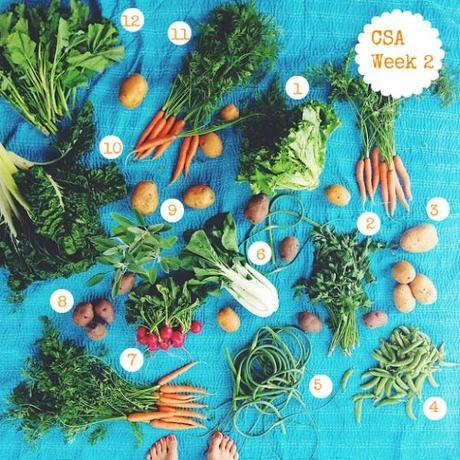
This week’s box had some new vegetables including broccoli rabe, and Adirondack blue potatoes. I should have kept some of them separate for our mystery food challenge since neither I, nor the kids, have tried them before. But they were so perfect for a July 4th red, white and blue potato salad that I used them all in one fell swoop.
Given that we had a few families visiting the lake this weekend, I also loaded up on a few extras that weren’t in my box.
Here were the contents of Week 2’s box:
- Green leaf lettuce
- Italian parsley
- Yukon Gold potatoes (from their regular farm stand)
- Sugar snap peas
- Garlic scapes
- Bok choy
- Red radishes
- Adirondack blue potatoes
- Sage plant
- Swiss chard
- Baby carrots
- Broccoli rabe
*not pictured (in hiding?) were a boatload of English peas
Aside from the Bialas produce, I picked up some local strawberries and blueberries from another vendor at the Ringwood Farmer’s Market, The Orchards of Conklin, and a pork shoulder from Snoep Winkel Farm.
The kids have been pretty excited to pick up the box because it brings mealtime and playtime together. After I set out the vegetables and get them ready for washing & bagging, Lauren now asks me if she can do her own vegetable artwork. In theory I don’t have a problem with it, but it makes for a gigantic clean up effort. But if that’s what it takes to get the kids interested in eating their greens, I’m game.
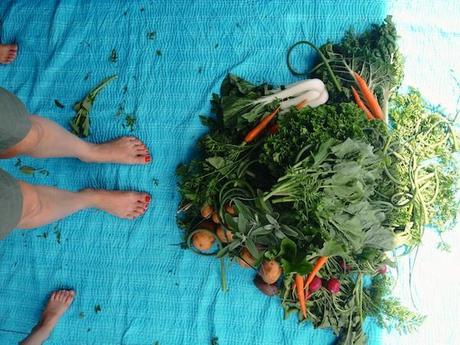
One of the first things that the kids like to eat are the carrots. With the greens and peels intact. I’m a peeler myself, but the skins on these baby carrots are so thin, that they’re downright delicious straight from the ground with nothing but a quick wash.

This week, my first dish was a beet hummus, using some leftover beets from last week’s box, to serve as a dip for the radishes. To call this dip hummus is a bit of a stretch since it contains no tahini, and a fair amount of yogurt. But with its chickpeas and garlic, it’s about as close as Lauren will come to tasting true hummus given her sesame allergy. Potato potah-to, it’s still pretty fantastic, and I’ve included the recipe below.
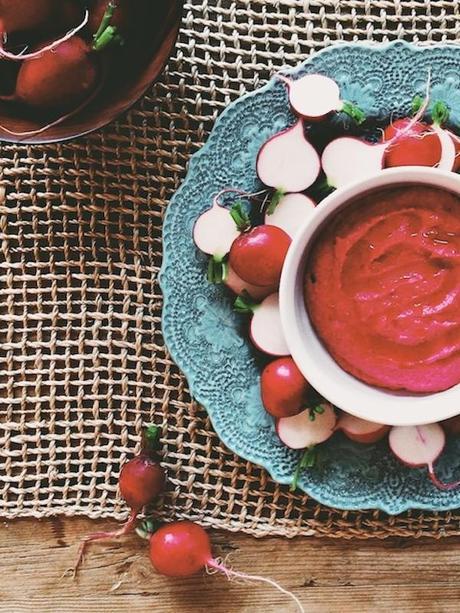
To make the beet hummus:
Blitz a garlic clove in a food processor until minced.
To the processor, add a few roasted beets (roast the beets in foil at 350 degrees for an hour, let cool, and then slip from their skins), a 14-oz can of garbanzo beans, 14-oz can of butter beans and then pulse. With the motor running, add a ¼ cup of olive oil in a slow stream to emulsify. Add a 6-oz container of yogurt and a tablespoon of Harissa; blend to incorporate. Season with salt and pepper.
(Optional) Serve with a drizzle of olive oil, a sprinkling of Maldon salt, and/or chopped fresh herbs.
The hummus was also really great stuffed into a toasted pita with a basic tabbouleh which I made with our farm share parsley, a tomato, bulgur and some lemon juice + olive oil. Feeling like I was going with a Mediterranean vibe that day for lunch, I rounded things out with some green leaf lettuce topped with grilled calamari. We don’t do this every day, but we should. It took almost no time to prepare and was a great combination of healthy and delicious.
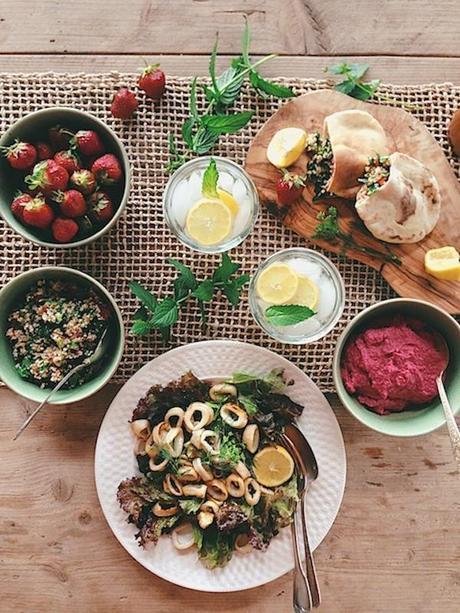
We had fun with our greens at lunch this week and opted one day for a pasta bar instead of our usual sandwiches. I was skeptical about whether this approach would encourage the kids to eat more veg, but was shocked when Sam layered broccoli rabe and blanched English peas over his pasta. On top of the mountain of bacon of course.
Lauren, my resident vegetable eater, just went for bacon and a splash of the pasta cooking water, which she referred to as “dishwater”. Appetizing. Feeling bad for my neglected vegetables, I loaded up on ricotta, heaps of English peas, mint, lemon zest and chili flakes and it was one of the best pastas I’ve had in a long time.

With the heat this week it was hard not to go crazy for cold things, so we made a lot of pops. Thinking that it might help entertain the kids this summer, I went hog wild on Amazon before we left the city, ordering a few different types of popsicle molds. The added benefit being that it gets the kids off of the neon ice pops from the A&P, and gives them some added nutrition.
These ring pops were one of their favorites – we pureed strawberries with some mint simple syrup and poured them into the molds. The best kind of accessory for beating the heat…

I then swirled some of the leftover strawberry mixture into plain Greek yogurt, and froze some into ice cream-shaped pop molds. Although the mint worked for the ring pops, the flavor in the yogurt pops was too overpowering for my guys who were expecting these to taste exactly like their frozen Stonyfield Farms strawberry squeezers. And were sorely disappointed that this wasn’t the case.



Don’t let that last picture of Lauren fool you. She loved her first bite, and refused to eat the rest.
But all was not lost. I’d saved the last of the strawberry mint mixture for cocktail hour: daiquiris, with a hit of fresh lime.

On the topic of cocktails, it would be horribly insensitive for me to not mention a little contraption that I discovered recently. Called the ice cream ball, an inner canister similar to an old-fashioned hand-cranked ice cream maker is placed into a blow up ball. So while the kids were passing the ball back and forth on the lawn….
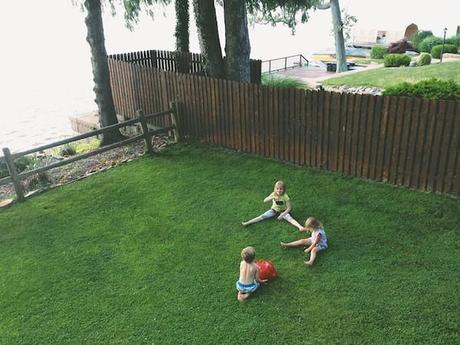
…they were actually making the soft-serve vanilla ice cream that was the foundation of my Bailey’s-spiked root beer float:
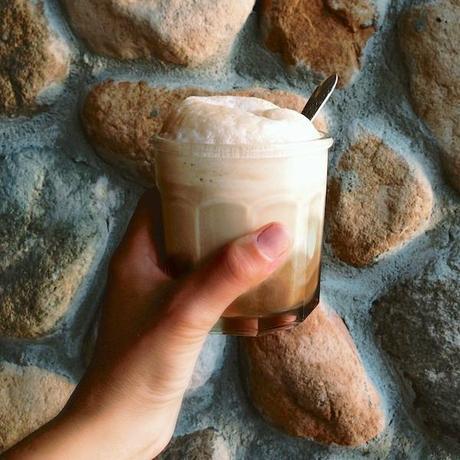
I did save some ice cream for the kids. Not a lot, but enough to give them each a bowl for their own mix-ins like chocolate chips. And they’re supposed to be eating their greens this week right? Which brings me back to Bialas.
Have I ever mentioned that with a CSA you end up with a mountain of surplus greens? Maybe others don’t, but I’m the kind of person who sheds a silent tear when I see people throw out their beet greens. So aside from all of the greens that you’re supposed to eat – the chard, the broccoli rabe, the kale – I also end up with all kinds of greens that are usually pitched – the carrot tops, the beet greens….
Enter lasagna. Because aside from things like gratins which use up huge piles of greens, I can’t think of any other dish that uses them in mass quantity.
The picture here is deceiving because what you see on top is blistered mozzarella; no tomatoes were harmed in the making of this dish. This lasagna uses grass-fed beef and a Parmesan-flavored white sauce, which are layered in between mountains of greens. It’s delicious, my houseguests don’t lie. Or maybe they were lying because they were eager to spend another night with us. I’ll never know; all I can say is that it was one of the tastiest lasagnas that I’ve made. I used Amanda Hesser’s white Bolognese sauce as inspiration for the meat layer, flavoring it with a little truffle salt.
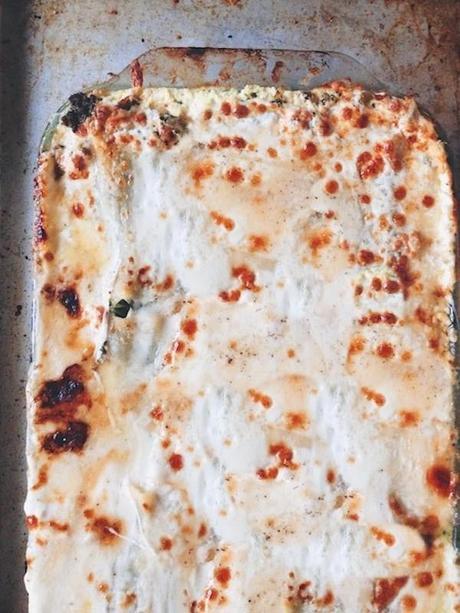
See recipe card below to find the instructions for the lasagna
Given that we had guests this week, I had to double down on some of the vegetables when I picked up my CSA box. The mountain of sugar snap peas caught my eye and despite the need to trim back their little hats & strings, I had to get them. I’d recently picked up some toasted sesame oil from Chelsea Market, and was eager to use it. I had The Barefoot Contessa’s simple snap pea recipe on the brain: sugar snap peas blanched quickly, and then seasoned with salt & pepper, tossed with a drizzle of sesame oil, and sprinkled with sesame seeds. My only modification is that I squeezed a bit of lemon to cut through the richness, and used Maldon smoked salt instead of Kosher. Sometimes the best recipes are the simplest.
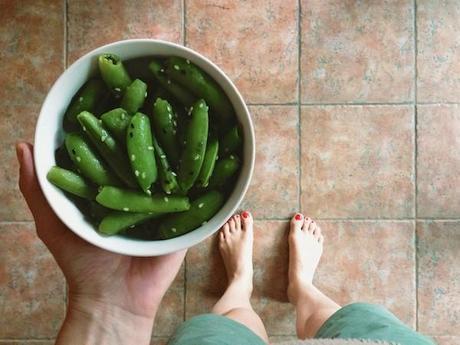
At last it was July 4th, and I had to bring out the big guns for dinner. Starting with this red, white and blue berry pudding made with the berries from Conklin Orchards. I think I might run and grab a bowl of leftovers now…
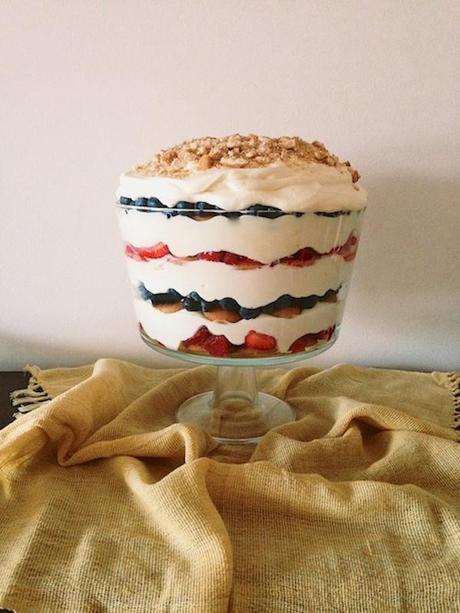
I’m back. This isn’t the kind of food I need to have lying around in my fridge during bathing suit season. If you want to make this – or the original banana pudding that’s based on the Magnolia Bakery classic, I link to it in this post.
The food for the barbeque was simple: aside from usual suspects like pulled pork sliders, burgers, and chili cheese dogs, we ate lots of fresh salads, including this quinoa version made with brown sugar & cumin-roasted carrots.
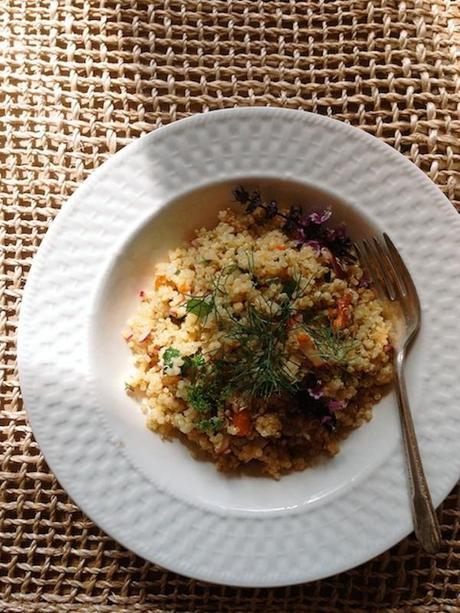
To make the quinoa salad:
Coat 8-10 cleaned carrots with brown sugar, cumin, salt and pepper, and roast in a 350 degree oven for 25 minutes. When soft, dice them and set aside while you make the quinoa. Follow the instructions on an 8-oz box of quinoa. When cooked, add 3-4 radishes that have been cut into matchsticks, ¼ cup of olive oil, and 2-4 tablespoons of sherry vinegar, to taste. Add the carrots, toss, and season with salt and pepper. Scatter freshly-chopped herbs over the top (we used dill and parsley).
And as I mentioned before, we used the Adirondack blue potatoes for a red, white and blue July 4th potato salad. My version didn’t have mayonnaise, just a mixture of whole grain Dijon mustard + some sour cream and Greek yogurt for creaminess.
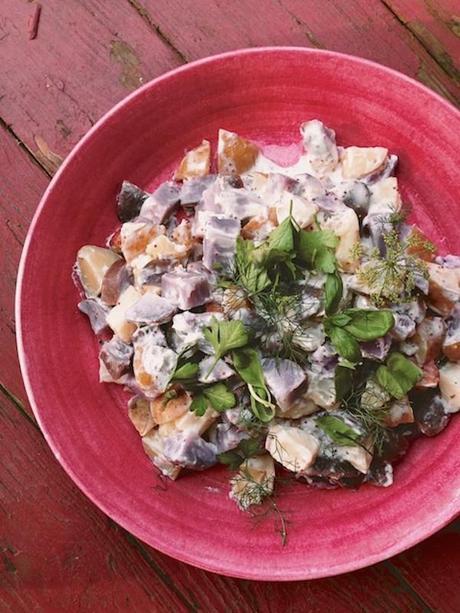
To make the red, white and blue potato salad:
Cut 4 of each of the following into large chunks: red potatoes, white boiling or Yukon gold potatoes, and either Adirondack blue or Peruvian purple potatoes. Add to a large pot, cover with cold salted water, and bring to a boil. Boil for 20 minutes, or until you can easily pierce the potatoes with a knife. While the potatoes are boiling, make the dressing: In a large serving bowl, whisk 2 tablespoons of whole grain mustard, with 2 tablespoons of white wine vinegar and a pinch of salt + black pepper. Add a ¼ cup of Greek yogurt, and a ¼ cup of sour cream, whisk to incorporate. In a slow stream, pour in ¼ cup of olive oil and whisk to emulsify. Taste and adjust seasoning. When the potatoes are cooked, drain in a colander, and immediately pour into the dressing, tossing to coat. The potatoes can be eaten either hot or cold. Optional: scatter fresh herbs over the top.
Somehow, despite having 16 guests for dinner, I cooked way too much food. But that’s always my problem. I’m an Italian grandmother in the making.
Hope this post gives you some more CSA inspiration for the week; as usual it was fun to work my way through our box. Looking forward to sharing all of the foods that I’ve been making with box # 3 over the past few days. Stay tuned for next week!
Grass-fed beef lasagna 2014-07-07 13:19:43 Serves 8 Write a review Save Recipe Print Prep Time 30 min Cook Time 1 hr 10 min Total Time 1 hr 40 min Prep Time 30 min Cook Time 1 hr 10 min Total Time 1 hr 40 min Ingredients- For the meat layer
- 2 Tbsp olive oil
- 4 ounces pancetta, diced
- 1 medium yellow onion, diced
- 1 medium carrot, diced
- 1 lb ground beef, preferably grass-fed
- 2 teaspoons truffle salt
- 1 teaspoon ground black pepper
- ¼ cup white wine
- 1 cup chopped, cooked rapini (I pulsed mine in the food processor until finely minced)
- For the white sauce
- 3 tablespoons unsalted butter
- 3 tablespoons all-purpose flour
- 3 cups whole milk
- ¾ cup grated parmesan
- Pinch truffle salt
- For the lasagna
- 1 15-oz container of ricotta cheese
- 1 egg
- 1 9oz package of no boil or oven-ready lasagna noodles
- 2 4-oz- packages of goat cheese, I love the Vermont Creamery brand
- 1 lb ball of fresh mozzarella, sliced (you should have enough slices to cover the whole top of the lasagna)
- 4 Tbsp of grated Parmesan cheese
- Salt & pepper
- To make the meat sauce
- Heat oil in a Dutch oven on medium heat and when shimmering, add the pancetta and sautee until golden.
- Remove with a slotted spoon to a to a paper towel-lined plate, and add your onions and carrots to the pot.
- Sautee for 5-6 minutes until softened, and then add back the pancetta.
- Add the ground beef and sautee for a few minutes, breaking up the pieces until it’s no longer pink.
- Add the truffle salt and pepper, then the white wine and deglaze the pan. Cook for one more minute.
- Add the rapini, stir to combine, and then take the pot off the heat.
- To make the white sauce
- Heat a medium saucepan on medium heat, and when ready, add the butter.
- Once the butter has melted, add the flour, and cook for a minute until well combined but not yet coloring.
- Slowly add your milk, going a little at a time so that your sauce doesn’t clump- whisk between each addition.
- Once the milk has been added, bring to a simmer, and simmer for a few minutes until thickened. It should coat the back of a spoon.
- At this point, add the parmesan cheese, and stir to combine.
- To assemble the lasagna
- Preheat the oven to 350 degrees.
- In a medium bowl, crack the egg into the ricotta, season with 1 ½ tsp of salt, and mix well. Set aside.
- Set up your lasagna assembly station – you should have at the ready: 1. The white sauce, 2. The noodles, 3. The meat, and 4. The goat cheese.
- In a large casserole dish, start your layering. Start with the white sauce, spreading enough to cover the bottom of the dish (should be about ¼ of your sauce as you’ll need a little extra to cover the dish at the end).
- Next, layer your noodles across.
- Spread 1/3 of your ricotta mixture over the noodles, then 1/3 of your beef, and lastly, 1/3 of your goat cheese. (You’re aiming for 3 total layers)
- Top with a final layer of noodles, and cover with the remaining sauce that you should have left over.
- Add the mozzarella slices and sprinkle the parmesan.
- If you’d like, drizzle a little olive oil over the whole lasagna, and season once more with salt and pepper .
- Cover with foil, and bake in the oven covered for 45 minutes. Remove the foil and bake for another 15 minutes and broil at the end for a final 2-5 minutes to get your cheese to blister.
- Most important, rest your lasagna for 5 minutes before slicing so that the pieces stay intact.
- Serve and enjoy!
- Although the recipe looks long, the lasagna itself doesn’t take much time to make and assemble, and can be done ahead of time. Just cover with foil and bake when ready, adding 10 minutes to your covered cooking time.

